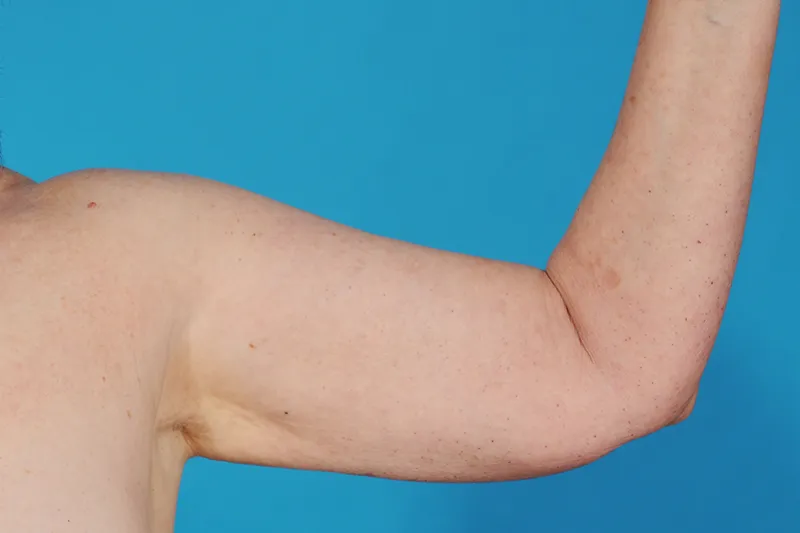Brachioplasty is a cosmetic body-contouring surgery that can improve the appearance of your upper arms. This is done by tightening sagging skin, supporting tissue, and removing pockets of fat. An arm lift is not a substitute for weight loss. Brachioplasty is ideal for those within several pounds of their ideal weight. When people gain a lot of weight, their skin stretches, and after weight loss, their skin may not have enough elasticity to spring back into place. An arm lift is a cosmetic surgery that helps improve the tone and definition of the upper arms by:
Reducing pockets of fat
Removing excess skin
Tightening supportive tissue
Smoothing over the remaining skin
Usually, patients decide on a Brachioplasty when lifestyle changes have failed to succeed such as eating healthier and exercising.
What is brachioplasty?
Brachioplasty is a cosmetic surgery that aims to improve the appearance of the upper arms by removing excess skin and fat and tightening the underlying tissue. It is also known as an arm lift or an arm reduction. Brachioplasty is often performed on people who have sagging or drooping arms due to aging, weight loss, or genetic factors.
Brachioplasty is usually done under general anesthesia or local anesthesia with sedation. The surgeon makes an incision along the inner or back side of the arm, depending on the amount and location of the excess skin and fat. The incision may extend from the armpit to the elbow or be shorter, depending on the individual case. The surgeon then removes the excess skin and fat and tightens the underlying tissue with sutures. The surgeon may also perform liposuction to remove any remaining fat deposits and improve the contour of the arm. The incision is then closed with sutures, staples, or adhesive tape.
Brachioplasty is an outpatient procedure that usually takes one to three hours to complete. The recovery time varies depending on the extent of the surgery and the individual healing process. The patients may experience some pain, swelling, bruising, numbness, or tingling in the arms for the first few days or weeks after the surgery. They may also need to wear a compression garment or bandage to support the healing tissue and reduce swelling. The patients are advised to avoid strenuous activities, lifting, or stretching their arms for four to six weeks after the surgery. They may also need to take antibiotics, painkillers, or anti-inflammatory drugs as prescribed by the surgeon. The patients will have visible scars on their arms, which will fade over time but may not disappear completely.
Brachioplasty is a safe and effective procedure that can improve the appearance and function of the upper arms. However, it is not a weight-loss surgery and it does not prevent the arms from sagging again in the future. The patients need to maintain a healthy weight, diet, and exercise routine to preserve the surgery results. They also need to follow the surgeon's instructions and have regular follow-up visits to monitor their progress and prevent any complications.

Who is a good candidate for Brachioplasty?
Those with droopy or saggy upper arms may benefit from brachioplasty surgery. The flaps of skin that hang down when you raise your arms may occur due to:
Changes in skin elasticity that occur with age
Losing a lot of weight with or without obesity surgery and maintaining a healthy lifestyle
Having certain genetic factors that cause your skin to sag
Lymphedema
What are the benefits of brachioplasty?
Brachioplasty can help restore a more toned and contoured shape to the arms, as well as enhance the self-confidence and comfort of the patients. Some of the benefits of brachioplasty are:
It can make the arms look slimmer and more proportionate to the rest of the body.
It can increase the confidence and satisfaction of the patients with their appearance. They may feel more comfortable wearing tight or more revealing clothing, such as sleeveless shirts, form-fitting tops, and swimsuits.
It can improve the muscle definition of the arms after working out, as the excess skin and fat will not obscure the results of exercise.
It can smooth and firm the skin of the arms, reducing the appearance of wrinkles, creases, or dimples.
It can reduce the risk of skin irritation, inflammation, infection, or hygiene problems caused by the extra skinfolds of tissue.
Brachioplasty is a safe and effective procedure that can improve the appearance and function of the upper arms. However, it is not a weight-loss surgery and it does not prevent the arms from sagging again in the future. The patients need to maintain a healthy weight, diet, and exercise routine to preserve the surgery results. They also need to follow the surgeon's instructions and have regular follow-up visits to monitor their progress and prevent any complications.
What happens during a Brachioplasty operation?
The operation is usually done under general anesthesia and takes 90-120 minutes. Your surgeon will make a long incision between your elbow and armpit. Depending on your condition and situation the incision could be minimal. Then segments of skin and fat will be removed and the remaining skin and tissue will be lifted resulting in a tight, smooth look. Some small tubes may be put in to drain any fluid or blood from the wound.

What are the risks of brachioplasty surgery?
Abnormal or excessive scarring
Excessive bleeding
Fluid accumulation (seroma)
Nerve, blood vessel, or muscle damage
Numbness
Surgical site infection
Wound separation (dehiscence)

How soon will I notice the results?
Brachioplasty is a cosmetic surgery that improves the appearance of the upper arms by removing excess skin and fat and tightening the underlying tissue. It is also known as an arm lift or an arm reduction. The results from brachioplasty are usually visible immediately after the surgery, although they may be obscured by swelling and bruising for the first few weeks. The patients should notice a significant improvement in their arms' shape, size, and contour, as well as a smoother and firmer skin texture.
The results from brachioplasty are long-lasting, as long as the patients maintain a stable weight and a healthy lifestyle. The patients can enjoy the benefits of having slimmer and more proportionate arms that match the rest of their body. They may also feel more confident and comfortable in wearing different types of clothing, such as sleeveless shirts, form-fitting tops, and swimsuits. However, the results from brachioplasty are not permanent, as the arms may sag again over time due to aging, gravity, or weight fluctuations. The patients may also have visible scars on their arms, which will fade over time but may not disappear completely.
Patients need to follow a healthy diet and exercise regimen to preserve the results of the surgery. By doing so, they can ensure a smooth and satisfying recovery from brachioplasty and enjoy the benefits of their new and improved arms.
When should I contact my healthcare provider?
Brachioplasty is usually done under general anesthesia or local anesthesia with sedation, and it involves making an incision along the inner or back side of the arm. The recovery time varies depending on the extent of the surgery and the individual healing process, but it usually takes from two to six weeks.
During the recovery period, it is important to follow the postoperative instructions given by the surgeon, such as cleaning, moisturizing, protecting, and medicating the wound, avoiding strenuous activities, lifting, or stretching the arms, wearing a compression garment or bandage, and taking painkillers, anti-inflammatory drugs, or antibiotics as prescribed. However, some complications may arise that require immediate medical attention. You should contact your healthcare provider if you experience any of the following signs or symptoms:
Severe pain that is not relieved by painkillers or worsens over time.
Fever, chills, redness, swelling, pus, drainage, or foul odor from the wound may indicate an infection.
Bleeding that soaks through the dressing or does not stop with pressure, may indicate a hematoma or a ruptured blood vessel.
Numbness, tingling, weakness, or loss of movement in the arm or hand, may indicate nerve damage or compression.
Shortness of breath, chest pain, palpitations, or coughing up blood, may indicate a pulmonary embolism or a blood clot in the lungs.
Swelling, pain, warmth, or redness in the arm or leg, may indicate a deep vein thrombosis or a blood clot in the veins.
These complications are rare, but they can be serious and life-threatening if not treated promptly. Therefore, it is essential to monitor your condition and report any changes or concerns to your healthcare provider as soon as possible. By doing so, you can prevent further damage and ensure a smooth and safe recovery from brachioplasty.
What is Brachioplasty recovery like?
When you wake up, you may have a tube underneath your skin. This is used to drain fluid from your wound. You may have some pain afterward. It’s normal to have a little fluid drain from the incision site. Patients will be asked to wear a snug-fitting sleeve to minimize swelling. You should not put too much pressure on your incisions as they heal. Arm lift recovery also includes:
Changing bandages and elevation on pillows as necessary.
Getting plenty of rest and eating a healthy diet, promotes healing.
Avoid strenuous exercise and heavy lifting for a period of recovery.
Wearing a compression garment for several weeks.
You will see the results of your Brachioplasty right away. They will last as long as you keep a stable weight.
Conclusion
Brachioplasty is often performed on people who have sagging or drooping arms due to aging, weight loss, or genetic factors. It can help restore a more toned and contoured shape to the arms, as well as enhance the self-confidence and comfort of the patients. Brachioplasty is not a weight-loss surgery and it does not prevent the arms from sagging again in the future. Brachioplasty is a safe and effective procedure that can enhance the appearance and function of the upper arms. However, it is not a one-time solution and it requires proper preparation, care, and patience. The patients need to maintain a stable weight and a healthy lifestyle to preserve the surgery results.